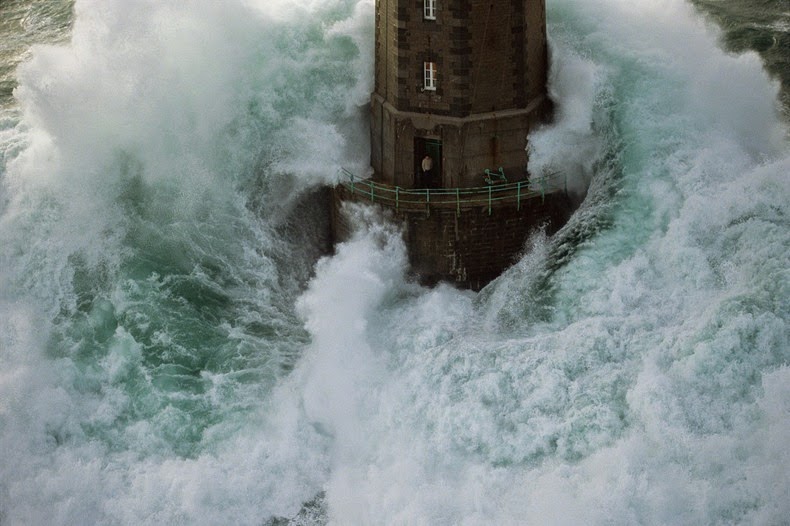A unique way of life for the many men and their families who manned our lighthouses for well over a century, lightkeeping was also a demanding, skilled and rewarding role. Despite the fact that the 1980s brought technological advances that meant lighthouses could be automated – lessening the need for permanent lightkeepers on site – it’s still the stories of the men who tended the light that draw us back to these coastal towers. The very last lighthouse automation on these shores came into effect in 2012.
Keeping Watch
In today’s busy, always-on age it’s easy to romanticise an isolated coastal life surrounded by stunning scenery. There were no doubt many good days but there was also plenty of danger among nature’s beauty, not to mention the unending routine of daily work. Confined to a lighthouse station with the close and inescapable company of maybe only one or two other men for weeks on end, it’s little wonder that ex-lighthouse keepers say it took a ‘special sort’ of character to take on the role!

Duties Day & Night
Lighthouses ran like clockwork with meticulous timing and attention to detail. There were usually three keepers and the clock was divided into six four-hour watches. The duty lighthouse keeper’s main job was obviously to ‘keep a good light’ as the rules and regulations put it. In the days of paraffin-vapour lamps that meant tending the light in the lantern of the lighthouse, and regularly winding the rotation mechanism that controlled the light’s flash. When electrification came along for the lights and the rotation mechanism, life was made much easier. The keepers could then spend the night in the messroom or kitchen watching an indicator to check the light was working.
Fog Watch
A major hazard for shipping, the keepers would always be watchful for fog. If fog rolled in, watches were doubled with one keeper operating the fog signal and the other tending the light. When the fog was bad enough, the keeper sounded the fog signal, by detonating an explosive or sounding a siren.
Red Foghorn at St Johns Lighthouse Donegal. Great Lighthouses of Ireland
Keeping it all Shipshape
The lighthouses were always kept impeccably spick and span. In true maritime tradition, everything had to be ‘shipshape’. So, as well as their watch duties, lighthouse keepers also spent a lot of time on ‘housework’ doing tasks like cleaning the lighting apparatus, polishing the optic and lantern glass, checking and servicing the engines, painting, keeping boat-landings and steps free of seaweed, not to mention keeping the accommodation clean.
While the keepers’ priority was the light and other Aids to Navigation, they also kept an eye on the water and on vessels that passed their way. Keepers would even get calls from fishermen’s wives asking for updates on their husbands’ whereabouts at sea!
Time Off
Usually, each man was at the lighthouse for six weeks at a time and then on leave for two. On island and remote headland lighthouses (like Clare Island, Loop Head, Valentia Island or Fanad Head) they might see no one but other keepers and the crew of the relief boat during that period. Separation from their families was difficult at times. At Ballycotton in East Cork however, the keepers’ families even stood on the quay on the mainland at a certain time each day to wave to their fathers.
Food
Where conditions permitted, the keepers would sometimes have a garden and maybe a few chickens. Fresh vegetables and eggs were a welcome addition to a diet that often relied on dried and tinned food.
Offshore lighthouses would receive a package of fresh food on a ‘relief day’ (when a keeper changed shifts). This, of course, was weather dependent! Sometimes the relief boat could be delayed for days or even weeks, so the men kept a large stock of food at the station just in case.

Today
There are 70 lighthouses around the island of Ireland still at work today. Twelve of these are part of Great Lighthouses of Ireland and are dotted around the Irish and Northern Irish coast. They stand as testament to these lightkeeping men and their proud, steadfast tradition of service and dedication to safety at sea.
BBC’s article shares about whats it like to live in a lighthouse.
You can experience something of life as it was at one of the Great Lighthouses of Ireland. Many of the lighthouses offer comfortable and characterful visitor accommodation in what were once the lightkeepers’ very houses.
Find out how you can enjoy an unforgettable lighthouse stay of your own. From escapes along the Wild Atlantic Way to the beauty of Ireland’s Ancient East – the coastal life is calling!

